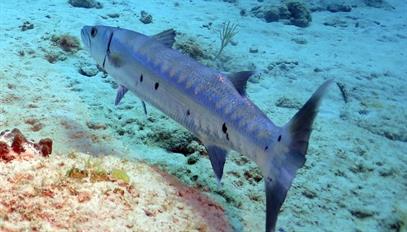



Sphyraena barracuda
| Ecological Descriptors | ||||
| Habitat | Size (cm) | Diet | Behaviour | Sex |
| EPel/ Pel | 30cm-1.8m | Pisc | I (Sh) | F |
Great Barracuda
Great Barracuda
Description:
Adults: Body long (arrow form), cylindrical and silvery, usually with scattered dark blotches on the lower sides. Can darken, showing side bands, helping to blend in to some environments. Dorsal fins widely separated. Tail fin double emarginate with pale tips on each lobe. Top of head between eyes flat or concave. Mouth large, with a large overshot jaw with obvious pointed teeth.
Juveniles: Pale brownish with dark brown bands/ blotches vertically.
Ecology:
Found predominantly at or near the surface, but can be observed to 100 m. Juveniles occur among mangroves, estuaries and sheltered inner reef areas, adults occur in a wide range of habitats from murky inner harbours to open seas. Larger adults (>65cm) are usually solitary and found over reef areas and offshore waters. Large schools have been observed and are probably associated with spawning behavior. Feeds on fish, cephalopods and sometimes on shrimps (juveniles).
Life Cycle:
Males mature by year three and females by year four. The spawning season is from April to October. Young barracuda will spend their first summer in shallow nursery areas and move offshore to deeper water in late autumn. In the second summer, young enter mangrove habitat or deeper weed beds. In its third year, it enters coral reef habitat.
Adults: Body long (arrow form), cylindrical and silvery, usually with scattered dark blotches on the lower sides. Can darken, showing side bands, helping to blend in to some environments. Dorsal fins widely separated. Tail fin double emarginate with pale tips on each lobe. Top of head between eyes flat or concave. Mouth large, with a large overshot jaw with obvious pointed teeth.
Juveniles: Pale brownish with dark brown bands/ blotches vertically.
Ecology:
Found predominantly at or near the surface, but can be observed to 100 m. Juveniles occur among mangroves, estuaries and sheltered inner reef areas, adults occur in a wide range of habitats from murky inner harbours to open seas. Larger adults (>65cm) are usually solitary and found over reef areas and offshore waters. Large schools have been observed and are probably associated with spawning behavior. Feeds on fish, cephalopods and sometimes on shrimps (juveniles).
Life Cycle:
Males mature by year three and females by year four. The spawning season is from April to October. Young barracuda will spend their first summer in shallow nursery areas and move offshore to deeper water in late autumn. In the second summer, young enter mangrove habitat or deeper weed beds. In its third year, it enters coral reef habitat.


2




234

Great Barracuda Juvenile
241




